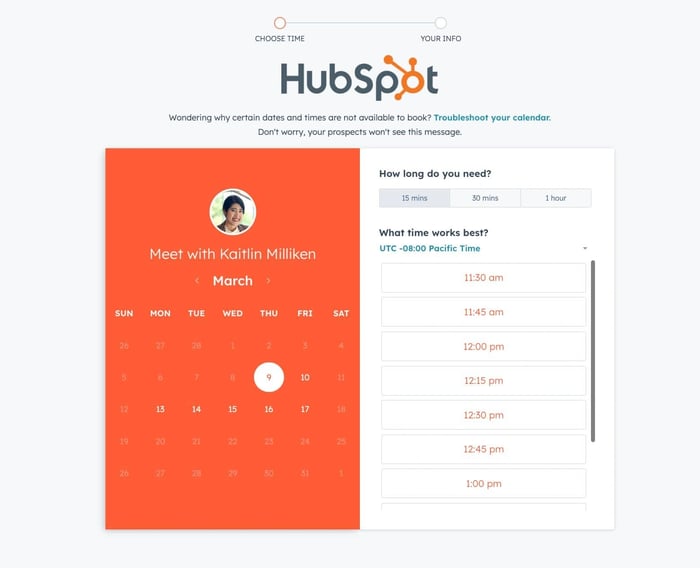The world of sales is constantly evolving — with new technologies and sales tactics emerging to help salespeople close more deals. Long gone are the days of cold calling, trade shows, and outdated methods.

Today, the best salesperson embraces marketing and a growth mindset. If you’re ready to level up your sales strategy, read through the top 20 sales tactics that will help you find and close more deals this year.
What are sales tactics?
Sales tactics refer to the various methods and strategies employed by sales professionals to persuade and convince potential customers to purchase a product or service. These tactics are designed to influence a customer's decision-making process, address their concerns, and ultimately lead them to make a purchase.
20 Sales Tactics That Work
Every team will develop its own unique sales strategy. However, these sales tactics offer a great starting point. Begin exploring below.
1. Adopt warm calling.

If you’re still cold-calling prospects and think it’s a great way to generate new opportunities, it’s time to revamp your strategy. Cold calling is difficult and negatively impacts your brand and potential success. It's also not nearly as effective as inbound selling.
Warm calling is preferable over cold calling. With warm calling, you connect with prospects who have already shown some level of interest or familiarity with your company or product. You’re less likely to confront unwilling prospects.
Warm calling typically involves contacting leads who have interacted with your company in some way, such as filling out a form, visiting the website, or attending an event. This makes it easier to establish a connection with the prospect, as they are more likely to be receptive to the sales message.
Of course, you still need to do call prospecting. Research to offer up a compelling reason for your initial call, work inbound leads that want to talk to you, and provide helpful insights to potential prospects on social media before engaging.
2. Utilize inside sales.

Back in the 1990s, inside sales was a stepping stone, not a career. In today’s world, actually meeting face-to-face is a nice to have, not a requirement. Inside sales, or remote selling, offers a more efficient and scalable process.
In the past, even early-stage sales calls were done in person. Meeting in person was not only expensive, but it was also a time sink. A simple 45-minute meeting became a three-hour ordeal — and all this just to start a relationship and conduct a basic needs analysis.
You had to dress formally, print out directions (remember, this was before smartphones), travel to the prospect’s office, wait in the parking lot, make small talk with the receptionist, and then make more small talk with your prospect before you could get down to business.
In-person meetings are often inefficient. Leverage inside sales to start relationships and for most transactions. Face-to-face meetings can be reserved for high-value prospects.
3. Be realistic about what your product can do.
You may feel tempted to paint your product as the solution to every problem your client faces. However, overselling the product can lead to challenges down the line. If your prospect’s expectations are not met, you may face high churn and dissatisfied customers.
So remember, don’t oversell. If you’re dealing with a 28- or 56-day sales cycle, you’ll be speaking with your prospects frequently. You can’t lie, and you need to sweat the details.
Be realistic about what your product can do and where your solution will alleviate customer pain. You’ll be more likely to garner repeat business.
4. Talk about your competitors.
Today, technology is homogeneous. Many companies offer similar software solutions, giving customers a wide range of options to choose from.
Be sure to discuss what makes your team different from competitors. The real differentiators are culture, company, and your ability to solve problems. Don’t be afraid to leverage the unique values that set your team apart.
Remember, your product demonstration is an end-all, be-all — everything you do before and after matters.
5. Personalize your solutions.
Today, 62% of consumers expect personalization from the brands they work with, according to Twilio. Those who fail to deliver will lose customers. Further, 49% of respondents in the same study said they would become repeat buyers if personalization is offered.
Make sure everything about your product, and the process you use to sell it, has a personal touch. Your emails should be addressed to the buyer. Your solution should be tailored to that prospect’s specific business needs.
You have to ask pertinent questions that pull out relevant information and make 100% sure you understand your prospect’s situation before you begin making any sort of recommendation.
6. Try the Negative Reverse Selling strategy.

If a prospect keeps ghosting your meetings, won't answer your calls, and isn't opening your emails, it might be time to get honest with them and hope for honesty in return. That’s where the Negative Reverse Selling strategy comes in.
Negative Reverse Selling is a tactic developed by David H. Sandler in 1967 as a part of his selling system. When using this technique, sales representatives make the prospect feel like they’re the one pursuing the deal.
The sales rep convinces the prospect that the prospect’s business desperately needs your. The prospect almost forgets that they’re being sold to.
To use this tactic, here’s what to do:
- Discuss your prospect’s business and pain points in depth.
- Ask plenty of questions to determine the root of customer pain.
- Once you have a comprehensive understanding of the person’s problem, explain how your solution can solve it.
Remember to focus on what your team can do to improve your customers’ lives. This helps the interaction feel less like a traditional sales transaction.
7. Take the time to understand your customer.
Landing a one-call close is a huge rush and seems like a quick win. But if you’re just paying attention to the short term, you may miss huge warning signs that your prospect won’t be a good customer.
Instead of speeding ahead to close a deal, take the time to really understand your customer’s needs and expectations. Delve deeper into your prospect’s situation so they’re completely informed about their decision.
Best-fit, informed customers won’t churn out of your customer base in a few months.
8. Focus on building relationships.
Not every interaction you have as a rep should be geared toward closing a sale. Networking with potential customers can help you foster deeper connections. You can then sell to them when the time is right or use their insights to improve your offering.
LinkedIn is a valuable online tool for relationship building. Find people who might be a great fit for your product. Then, send a personalized connection request. You can take a look at their posts and keep track of the promotion. If you notice their needs align with what you sell, you can follow up with an offer.
In-person events are another way to forge these relationships. Not only will you connect with potential future customers, you can assess industry trends that can help you improve your offering.
9. Develop a strong social media presence.
Social media is more than a distraction. These platforms are powerful tools for closing sales. Today, 61% of organizations engaged in social selling report revenue growth. In fact, sales professionals with a strong social selling index on LinkedIn have 45% more sales opportunities than those who don’t.
Use social media to build awareness of your product and services. If you are not on LinkedIn, TikTok, Twitter, Instagram, or Snapchat, then it's time to join the conversation.
10. Lean on your marketing team.
Alignment between your sales and marketing team is a key driver of success. Organizations that have robust alignment can see 20% growth annually. So remember, you’re only as good as your marketing department.
If you don’t have relationships with your marketing team, start by finding three marketers and connecting over coffee (virtual and in person). Share common pain points you hear from customers and ask for marketing collateral that they have related to these issues.
This should be the start of an ongoing relationship. Your departments should collaborate regularly. Bring the marketing team ideas for ebooks or blog posts that would help you in your sales process. Marketing can help you hit your number, but they need your help to do so.
11. Diversify where your leads come from.
If you’re doing all of your prospecting on LinkedIn or at in-person conferences, you’re missing out on huge swaths of potential customers.
Call your cousin and ask who at their company is responsible for the business area relating to your product. Call your closed-lost accounts from 2021. Go to a networking event and give out your business card while asking how you can help.
Above all: Make sure you’re looking for leads in multiple places.
12. Use an automated meeting scheduler.

Scheduling a meeting over email often leads to an unnecessarily long thread of messages. An automated meeting booking app can save you from the back and forth.
You can also use HubSpot Sales to improve the meeting scheduling process. Your prospects just have to choose an available time on your calendar that works for them. Then, they’ll receive automatic confirmation of the meeting.
13. Always be learning.
As a sales professional, the information you need to be successful is always changing. You need product knowledge, sales knowledge, and customer knowledge to get the right results.
Ask your manager to review your calls and ask for ways to improve. It’s important to stay in a growth mindset and seek new information and skills constantly. Read blogs or go to industry events to learn about new trends.
You can also take the HubSpot inbound sales certification to teach yourself inbound selling concepts and learn how to apply them to your own sales process.
14. Sell with a team.
Team selling always wins. If you are missing your numbers, or even if you’re just looking to level up, a team approach can help you grow.
See if your manager can join you for sales calls and give you tangible tips for improvement. You can also work with a sales coach who can share some of their tried-and-true best practices.
Then, get a sales mentor and meet regularly. Find someone who might be a bit further in their career and has shown a consistent approach to exceeding their numbers. You can both discuss ways to improve and how to advance your career.
15. Prioritize work-life balance.
Tired of the hustle culture? Most of us are. It's not sustainable to grind for 14 hours a day, seven days a week. It's important to have grit, but it's equally important to have balance.
Stay pumped up by getting enough sleep, eating a balanced diet, and surrounding yourself with good people. Take care of yourself — if you keep yourself healthy by exercising, staying motivated, and keeping your brain engaged, you'll be happier — and ultimately perform better.
16. Find creative ways to network.
Going to trade shows and setting up a booth is only one way to network. You’ll need to find new, creative ways to promote your product and yourself.
You should be reaching out to prospects on LinkedIn and other social media. However, you’ll also want to build your own brand and become a thought leader they trust. Consider writing blog posts, starting a podcast, or hosting webinars. This way you can grow your network and your credibility.
17. Have a thoughtful LinkedIn strategy.
Just because you have a distant, third-degree connection doesn't mean they're a qualified prospect. Instead, become part of pertinent groups on LinkedIn. Comment on and share articles in your feed.
Keep an eye out on what your prospects post and engage where relevant. Be sure to reach out only once you've made a meaningful, non-creepy connection.
A good rule of thumb for LinkedIn outreach? Always respond in kind.
For example, if a prospect "likes" an article you shared in an industry group, don't immediately send them a direct message asking for a phone call. Instead, reply to the article thread by thanking them for reading your article.
This might not be the fastest way to move leads along, but it will be far more successful than pushing a relationship before they’re ready.
18. Tailor your sales process.
Expecting every prospect to react the same way throughout your sales process is unrealistic. You might have prospects ready to sign on the dotted line halfway through your discovery call and others who need to talk to your lead engineer, their lawyer, and five executives before they're ready to buy.
Be flexible in your approach to each account, learn how to read the signs, and determine the next steps for any prospect you're working with.
Be sure to ask your prospect who needs to be involved in the buying process and how they prefer to communicate. This will give you a sense of how to keep in touch, who to connect with, and when to reach out.
19. Find the right call cadence.
If you call a prospect three times in a day and send two follow-up emails, you're coming on too strong. Don't assume your prospects are viewing your relentless "spirit" as admirable or a sign of dedication and hard work.
Finding the right call cadence is an important milestone for a salesperson and the team they work in. Here's what sales expert Jeff Hoffman recommends for a cadence that won't be off-putting for your prospect:
- Day 0: First touchpoint.
- Day 14: Second touchpoint.
- Day 21: Third touchpoint.
- Day 25: Fourth touchpoint.
- Day 27: Fifth touchpoint.
- Day 28: Sixth touchpoint.
- Day 29: (in the morning): Seventh touchpoint.
- Day 29: (in the afternoon): Eighth touchpoint.
20. Share your successes with your team.
The days of furtively clawing your way to the top of the leaderboard and staying there by keeping your most successful strategies to yourself are long gone.
Team selling is the way to get ahead at your company and close more deals. Whether you're a sales leader or a new rep, seek out your teammate’s tips and advice, and share the tactics you find most successful.
If a rep on your team has a call strategy that repeatedly solves a problem that your team gets a lot of, make her strategy an institutionalized part of your sales process and have her lead the training to the other reps.
Building Your Sales Strategy
There’s no one set of tactics that will work perfectly in every sales organization. That’s why it's essential to experience. Start testing these sales tactics today, and see what works in your organization. From there, you can incorporate the most successful ones into your strategy.










![Why Your Company Should Invest in Inbound Sales During a Recession [Expert Insights]](https://blog.hubspot.com/hubfs/Recession%20inbound%20%281%29.jpg)

